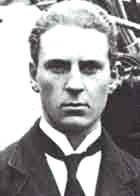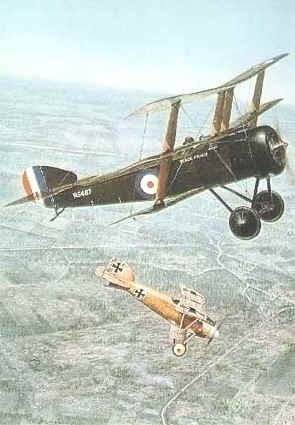 |
|
|||
|
|
||||
 |
Robert Alexander Little |
| - Australian Fighter Ace - | |
 |
|
| Many pilots from Britain's
dominions wore the uniform of the Royal Naval Air Service. R A Little
was one such, an Australian born in Melbourne, Victoria, on 19 July
1895. He was educated at Camberwell Grammar School from Year 2 until
Year 8, after which time he transferred to Scotch College. It is worth remembering
that in Melbourne in the early 1900's it was only possible to
matriculate from certain schools. Camberwell Grammar only went up to
Year 10 at this time. To further his education CAPT Little would have
had to have transferred; however, the greatest amount of his school time
was spent at Camberwell Grammar.
When the war started he was desperate to join up and see action before it was all over. When in August 1914 he discovered that there were already 500 applicants at the Point Cook Military Flying School and believing he had little chance of obtaining a entry without a long wait, he decided to sail for England at his own expense.
Under Squadron Commander G R Bromet they began with three flights of Nieuport 17s, Sopwith 1 1/2 Strutters and Sopwith Pups but by December it was the first all-Pup squadron in action. Little and his fellow naval pilots were delighted with the new aircraft. On 11 November, Little made his first kill, an Aviatik C1, while flying a Pup N5182 although most people consider his first kill to have been on the 23rd when he shot down a two seater just north of La Bassee. and by December had claimed two Halberstadts.
The German made a perfect landing but Little's triplane turned over on landing and the German pilot (who had been a Rhodes scholar at Oxford before the war) had to help his notional captor out of the upturned Sopwith, remarking it rather looks as if I shot you down, not me'. In spite of this humiliation, Little's victory log lengthened throughout May. By the 26th it totalled twenty-eight and by the end of July he had destroyed thirty-seven enemy aircraft. The DSO and Bar to his DSC were gazetted on 11 August 1917 and the Bar to his DSO on 14 September 1917. In the summer Of 1917 Little was recalled to RNAS Dover for instructional and administrative duties where he tried a new Sopwith Dolphin and a Spad. He could not stay out of the fighting for long, however, and was posted back to Naval Three, soon to become 203 Squadron RAF commanded by Raymond Collishaw. His appetite for air fighting was insatiable. When not sharpening his eye on the airfield's rabbits with a .22 rifle, he would lead offensive patrols with scant regard for danger. On one occasion he attacked a particularly effective German Flak battery near La Bassee by flying in at 7000 feet, spiralling earthwards in a controlled 'falling leaf spin and finally flattening out at very near ground level to scatter the amazed gunners with machine-gun fire and then hedge-hop home. On the day Richthofen was killed, 21 April 1918, Little flying a Sopwith Camel picked off the rear-most aircraft in a formation of twelve from Jasta Boelcke. Six avengers turned angrily on Little's Camel and shot his controls away. The aircraft went down to within 100 feet of the ground before flattening out with a jerk. Little, having unstrapped his seat belt against standing orders, was thrown clear as the Camel ploughed into the ground north of the Forest of Nieppe. Two enemy aircraft followed him down to rake the wreck with fire, but Little was out and still fighting, blazing away with his Webley until some British infantry joined in with Lewis guns. On 28 May Major Booker, Little's comrade from Naval Eight and now Commanding Officer 201 Squadron RAF, was summoned to the scene of a crash where a Camel had come down in the French lines. He got a terrible shock - the pilot still at the controls with a bullet through his heart was Little. The previous evening Little had taken off in Camel B6318 in an attempt to intercept German Gotha bombers making a night raid. It seems that he was killed by one of the Gothas' defensive gunners, while blinded by a searchlight beam, and crashed.
|
 |
He was buried in Wavans
cemetery and Australia had lost its foremost fighter pilot. Robert
Alexander Little was married in 1916 and left behind a young widow and
a baby son.
Left: Robert Alexander Little's wife shortly after they were married. |
COMBAT CLAIMS
| Kill | Date | Type | Result | Location |
| 1 | 23/11/1916 | Unidentified 2 seater | Destroyed | La Bassee |
| 2 | 4/12/1916 | Halberstadt D II | Out of control | Bapaume |
| 3 | 20/12/1916 | Unidentified 2 seater | Out of control | Fontaine |
| 4 | 7/1/1917 | Albatros D II | Out of control | Grevillers |
| 5 | 7/4/1917 | Albatros D III | Destroyed | Lens |
| 6 | 9/4/1917 | Halberstadt D II | Out of control | Noyelles-Lens |
| 7 | 21/4/1917 | Albatros D III | Destroyed | Oppy |
| 8 | 24/4/1917 | Aviatik C | Captured (shared) | Auchel |
| 9 | 28/4/1917 | Unidentified 2 seater | Destroyed | Oppy |
| 10 | 29/4/1917 | Albatros D III | Destroyed (shared) | Douai |
| 11 | 30/4/1917 | Albatros D III | Out of control | E Arras |
| 12 | 30/4/1917 | Albatros D III | Out of control | E Arras |
| 13 | 2/5/1917 | Albatros D III | Out of control | Vitry |
| 14 | 9/5/1917 | LVG C | Out of control | S E Lens |
| 15 | 9/5/1917 | Albatros D III | Out of control | S E Lens |
| 16 | 10/5/1917 | Albatros D III | Out of control | Lens |
| 17 | 18/5/1917 | DFW C | Destroyed | N E Lens |
| 18 | 18/5/1917 | Albatros D III | Destroyed | N E Lens |
| 19 | 23/5/1917 | Albatros D III | Out of control (shared) | W Douai |
| 20 | 25/5/1917 | Albatros D III | Out of control | Quiery la Motte |
| 21 | 16/6/1917 | Unidentified 2 seater | Destroyed (shared) | Wingles |
| 22 | 21/6/1917 | Albatros D V | Destroyed | Henin-Lietard |
| 23 | 26/6/1917 | Unidentified 2 seater | Destroyed | Acheville |
| 24 | 29/6/1917 | Albatros D V | Out of control (shared) | E Lens |
| 25 | 3/7/1917 | Albatros D V | Out of control | Lens |
| 26 | 3/7/1917 | Albatros D V | Out of control | Lens-La Bassee |
| 27 | 6/7/1917 | Unidentified 2 seater | Destroyed | N Izel |
| 28 | 10/7/1917 | Albatros D V | Out of control | Fampoux |
| 29 | 12/7/1917 | Albatros D V | Out of control | Vitry-Drocourt-Queant |
| 30 | 13/7/1917 | Unidentified 2 seater | Out of control (shared) | Lens |
| 31 | 13/7/1917 | Albatros D V | Captured | Croiselles |
| 32 | 15/7/1917 | Albatros D V | Out of control | Lens |
| 33 | 16/7/1917 | Unidentified 2 seater | Out of control | Gravrelle |
| 34 | 20/7/1917 | DFW C V | Destroyed (shared) | Lens |
| 35 | 21/7/1917 | Albatros D V | Out of control | E Oppy |
| 36 | 22/7/1917 | Unidentified 2 seater | Out of control | Rouvroy |
| 37 | 22/7/1917 | Albatros D V | Out of control | Lens |
| 38 | 27/7/1917 | Unidentified 2 seater | Destroyed (shared) | Loos |
| 39 | 1/4/1918 | Fokker Dr I | Destroyed | Oppy |
| 40 | 6/4/1918 | DFW C V | Destroyed | Lens |
| 41 | 7/4/1918 | Fokker Dr I | Destroyed | Violanes |
| 42 | 9/4/1918 | Albatros C | Destroyed (shared) | Givenchy |
| 43 | 11/4/1918 | Albatros D V | Destroyed | Bac St Maur |
| 44 | 21/4/1918 | Pfalz D III | Out of control | Bailleul |
| 45 | 18/5/1918 | Pfalz D III | Out of control (shared) | Neuf Berquin |
| 46 | 22/5/1918 | Albatros C | Destroyed | Mory-St-Leger |
| 47 | 22/5/1918 | DFW C | Destroyed | Morchies |
| Victories 1-4 were scored while flying a
Sopwith Pup. Victories 5-28 were scored flying Sopwith Triplanes. Victories 29-47 were scored flying Sopwith Camels. |
||||
| Little's score is recorded as at least 47 destroyed and out of control, plus many either forced to land or driven down. The most up to date research lists this as comprising 17 destroyed and 5 shared destroyed, one captured, 21 out of control and 2 shared out of control. These totals make Robert Alexander Little not only the highest scoring Australian ace of World War One, but also the highest scoring Australian ace ever as no one in any other war has achieved greater battle success. |


